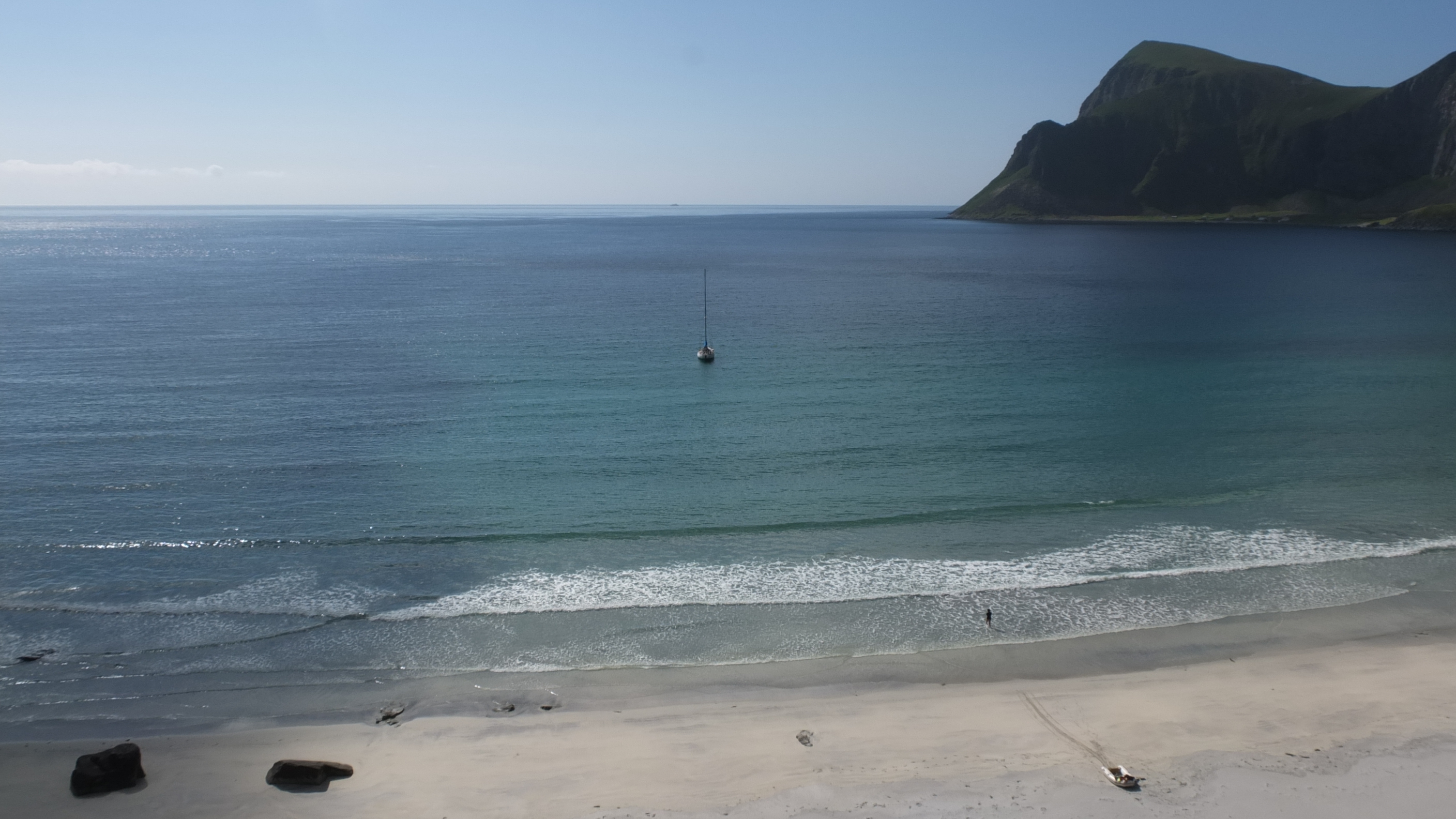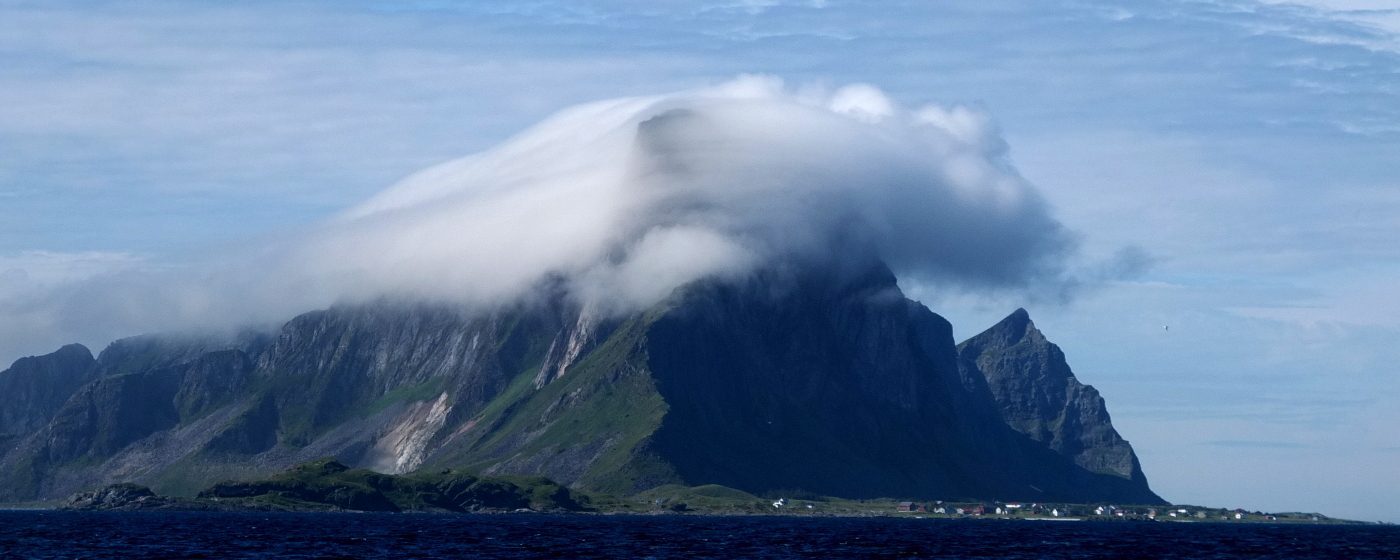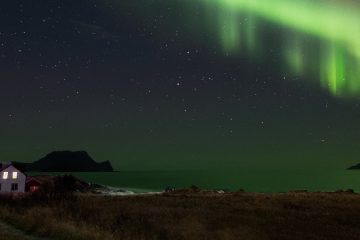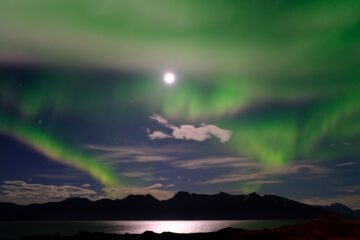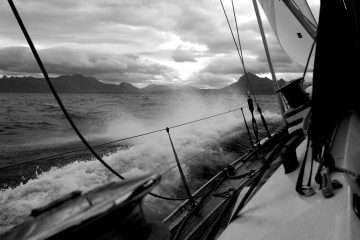The sea is like a white noise,
the texture of a sheet of paper
where nature draws its islands
and men write their dreams.
The Lofoten archipelago is a young mountain chain of wild and courageous peaks which sinks dramatically into the North Atlantic Ocean from the coast of Norway well above the Arctic Circle. Its geographic exuberance charms sailors and climbers alike. A handful of bigger islands delivers abundant verticality, while a galaxy of islets, coves and rocks provides endless excitement to those sailors and fishermen who search here the romanticism they need since the dawn of ages.
It’s not kindergarten sailing. The west coast is swept by frequent gales and almost incessant swell, while the Vestjorden side is seldom less entertaining with its currents, southwesterlies and rocks. Calm seas must not be expected, although they do happen, brightening the days with amazing views and breathtaking scenery. This is where the word Maelstrom come from, more precisely from the passages between Moskenesoya, Vaeroy and Rost. And the Vikings has been using the word Fallvind well before the English started using Williwaw to describe strong and hell-bound gusts from steep mountains. The same capricious nature provided abundant shelter and even more abundant cod, and the sailor is rewarded with bomb-proof and picturesque ports strategically placed where most needed, including the west coast. Which, by the way, is also blessed by such a maze of skerries and islets that render a cruise around the Lofoten a unique experience.
Once you moor at the massive dock of Vaeroy and you walk among the unassuming usual pretty houses you will not have the impression to be walking around the richest municipality in Norway, and possibly of the planet. When the cod stock started to decline in the 80s, many Norwegian offshore communities were invited, and in some cases forced, to relocate inland and start farming. The Vaeroy people would have none of it, and instead invested in a bigger fleet, a classic ‘all in’ gambled. The fish stocks returned and now all you need to fish a cod in February is a stone. Result, these people are wealthy. And not altogether well disposed to tourists. And they might as well, leaving the magnificent island to boaters. Vaeroy is my favourite island. The combination of vertical cliffs, thin crests, white beaches, green valleys and daring peninsulas is a geographical spring of never ending perspectives and angles. And Vaeroy from faraway in the northern clouds is a show on its own. And from faraway you do not perceive the faint, ubiquitous smell of drying cod that seem to permeate the harbor. When asked how can they cope in the cod drying season, a local lady answered rapidly ‘I like it… smells of money’.
Moskenesoya is the top model of the Lofoten, its intrepid peaks among the stars of Instagram, especially the various breathtaking views of the fjords behind Reine piercing the sky behind some lucky climber, usually portrayed in various degrees of equilibrium – or lack of it – standing on top of some outstanding rock formation. I would not neither recommend Reine for a visit, preferring the nearby Sorvagen for a quiet night, nor the SE coast in general, preferring by far the staggering, stunning and steep westerly coast, weather permitting. There is an acceptable anchorage at the very south end of the island, then it’s a wild 20M ride to next port, Ramberg, under a continuous procession of peaks, crests, gullies and every other conceivable rock formation you can possibly imagine, with a stunning succession of beaches thrown in.
Vestvagoya to the northeast is less dramatic in its profile but rewards those who sail its northwest side with a very special blend of green valleys, audacious crests, white beaches and delightful ‘Local Hero’ style villages with mandatory beach and white Church, like Eggum for example. The sand is particularly white in this area. The wide gulf in the North side of the island is shallow and littered with rocks and islets, some of them natural park. On a grey and windy day its probably regarded as a potential sailboat graveyard for all its rocks and shoals, while on a sunny day it changes dramatically into one of the grandest and greenest swimming pools imaginable, with borough-wide surfaces of 4 metres of water glittering over white sand, the combination of which provides a really photogenic crystal green effect. The South coast is ‘business as usual’, with the excellent Harbour of Stamsund as a perfect stopping place.
Austvagoya confirms a generic trend of softening of the geographical features, with valleys here making their voice heard over the usual incumbent peaks. The Southern coast has been historically very important for the local fishing industry, with three important ports still in operations like Kabelvag, Henningsvaer and Svolvaer. The second is particularly interesting being partly artificial work of Genius. Two long islets forming a straight and conveniently deep channel have been linked at their exposed end by a massive breakwater, thus creating a perfect Venice style Harbour, with the basin enclosed by a continuous stretch of houses, wharves, deposits and fish factories all Painted white. Even if on the tourist side, it’s Worth a visit, last but not least because Henningsvaer boasts the Intagram star of all soccer fields, basically carved into the stones of th S end of theE island.
Skrova marks the boundary between the Vestfjorden and the fjords leading to the North and to Tromso. It’s a beautiful, unspoiled and perfectly positioned Harbour with a great whaling tradition. To make things clear they litter the place with harpoon cannons and whale images, many really poetic, others much less. A walk to the 250 metres summit of the island is certainly less daunting than other hikes around the archipelago but the views are certainly as rewarding.
From the west side of Skrova a channel goes inland through high walls and powerful mountains, littered with snow and ice even in August. It’s a completely different scenery, where water succumbs to the power of rock, and the sailor feel finally sheltered and protected by a huge natural Harbour.


